Are you now thinking of considering alternatives? If you have a monitor, mouse and keyboard that you’re happy with, you could use them with a New Apple iMac (21.5-inch 8GB RAM 1TB storage). That Mac’s late 2018 update impressed us in several respects. Well, not its graphics processor, although that can be fixed by connecting an external GPU via a Thunderbolt 3 port. (That’s also possible on other Macs, including the 21.5-inch iMac.) Can you do iMac (Retina 4K 21.5-inch 2019) RAM upgrade in 2022?
The $799 (£799/AUS$1,249) Mac mini has a 128GB SSD by default. You’ll get double that capacity for an extra $200 (£180/AUS$320). It’s easy to get pulled in by the classic strategy of upselling, however.
The Mac mini also supports aftermarket memory upgrades, although you may want a service provider to do it for you like the 21.5-inch iMac. If you check out iFixit’s guide to upgrading the Mac mini, then you’ll see that it’s not as simple as the 2012 design, taking 22 steps rather than 3. (The 2014 Mac mini’s RAM was soldered in place.)
The main improvements Apple has made to its 2019 iMac all-in-ones (AIOs) are their upgraded silicon engines. The best of these—an Intel Core i9 CPU and an AMD Radeon Pro Vega 48 GPU—are the sole province of the 27-inch 2019 iMac, and you have to pay significant upcharges for them. Apple’s smaller-sibling 21.5-inch iMac, on the other hand, doesn’t have quite the same lofty aspirations. The least-expensive model starts at just $1,099
In the box
21.5‑inch iMac with Retina 4K display, Magic Keyboard, Magic Mouse 2, Power cord, Lightning to USB Cable
Specifications – New Apple iMac (21.5-inch 8GB RAM 1TB storage)
| Display | 21.5-inch (diagonal) Retina 4K display, 4096-by-2304 resolution with support for 1 billion colors; 500 nits brightness, Wide color (P3) |
| *Processor * | 3.6GHz quad-core 8th-generation Intel Core i3 processor or 3.0GHz 6-core 8th-generation Intel Core i5 processor with Turbo Boost up to 4.1GHz |
| Video Support/Camera | FaceTime HD camera, Thunderbolt 3 digital video output |
| Connections and Expansion | 3.5 mm headphone jack, SDXC card slot, Four USB 3 ports (compatible with USB 2), Two Thunderbolt 3 (USB-C) ports, 10/100/1000BASE-T Gigabit Ethernet (RJ-45 connector), Kensington lock slot |
| Wireless | 802.11ac Wi‑Fi wireless networking; IEEE 802.11a/b/g/n compatible, Bluetooth 4.2 wireless technology |
| Height | 17.7 inches (45.0 cm) |
| Width | 20.8 inches (52.8 cm) |
| Depth | 6.9 inches (17.5 cm) |
| Weight | 12.5 pounds (5.66 kg) |
Compare Apple iMac models
| New Apple iMac (21.5-inch 8GB RAM 1TB storage) | Apple iMac 21.5-inch | Apple iMac 27-inch Retina 5K display | |
| Display | 21.5-inch (diagonal) LED-backlit Retina 4K display | 21.5-inch (diagonal), LED-backlit display | 27-inch (diagonal) LED-backlit Retina 5K display |
| Processor | 3.6GHz quad‑core Intel Core i3 or 3.0GHz 6-core Intel Core i5 (Turbo Boost up to 4.1GHz) | 2.3GHz dual-core Intel Core i5 processor; Turbo Boost up to 3.6GHz | 3.0GHz 6‑core Intel Core i5 (Turbo Boost up to 4.1GHz) or 3.1GHz 6‑core Intel Core i5 (Turbo Boost up to 4.3GHz) |
| Graphics | Radeon Pro 555X with 2GB of VRAM or Radeon Pro 560X with 4GB of VRAM | Intel Iris Plus Graphics 640 | Radeon Pro 570X with 4GB of VRAM, Radeon Pro 575X with 4GB of VRAM, or Radeon Pro 580X with 8GB of VRAM |
| Storage | 1TB (5400-rpm) hard drive or 1TB Fusion Drive | 1TB (5400-rpm) hard drive | 1TB or 2TB Fusion Drive |
| Keyboard and Mouse | Magic Keyboard, Magic Mouse 2 | Magic Keyboard, Magic Mouse 2 | Magic Keyboard, Magic Mouse 2 |
Can you do iMac (Retina 4K 21.5-inch 2019) RAM upgrade?
RAM types and Actual Maximum RAM Capacities
Likewise, the 21.5-Inch “Late 2015” iMac models (even the more expensive “Retina 4K” offerings), have a reported “8 GB of 1867 MHz LPDDR3 onboard memory” and OWC again confirmed that the RAM is soldered on these models. At the time of purchase, they could be upgraded to 16 GB for an extra US$200, but they cannot be upgraded at all after initial system purchase.
Sadly, for the 21.5-Inch “Mid-2014” iMac — the iMac “Core i5” 1.4 21.5-Inch (Mid-2014) — Apple notes that it has “8 GB of 1600 MHz LPDDR3 onboard memory.” OWC disassembled one and confirmed that the RAM is indeed soldered onboard and cannot be upgraded at all. This low-end model could not even be configured with more RAM at the time of initial purchase.
The 27-Inch “Late 2015” iMac models support four 204-pin 1867 MHz PC3-14900 DDR3 SDRAM SO-DIMMs. Officially, Apple supports 32 GB of memory, but OWC has determined that 64 GB actually will work if the memory conforms to exacting standards.
For the 21.5-Inch “Mid-2017” iMac models, Apple reports that they have 8 GB of “2133 MHz DDR4” or “2400 MHz DDR4” memory onboard. However, in a pleasant surprise, as first discovered by site sponsor OWC, the memory actually is not onboard and can be replaced or upgraded after the initial purchase of the Mac, it’s just unnecessarily complicated. Some models actually can support more RAM than Apple officially supports, as well.
For the 27-Inch “Mid-2017” iMac models, these systems have four easy-to-access 2400 MHz PC4-19200 DDR4 SDRAM SO-DIMMs (260-pin). Apple only formally supports 32 GB of RAM in the iMac “Core i5″ 3.4 27-Inch (Mid-2017), but it and all other 27” models from this line actually can support 64 GB of RAM.
For the 21.5-Inch “2019” iMac models – New Apple iMac (21.5-inch 8GB RAM 1TB storage), Apple reports that they have 8 GB of “2400 MHz DDR4” or “26666 MHz DDR4” memory “built into the computer” and “it can only be upgraded by an Apple Authorized Service Provider if you choose to upgrade at a later date.” In a teardown, site sponsor OWC determined that the RAM in this model actually is not built into the computer and it can be replaced or upgraded later, it’s just a pain to disassemble the computer to do so.
Finally, the 27-Inch “2019” iMac models, like their predecessors, have four easy-to-access SO-DIMM slots. Unlike their predecessors, they use faster 2666 MHz PC4-21300 DDR4 DDR4 SDRAM SO-DIMMs (260-pin). Curiously, Apple formally allows up to 32 GB of RAM in the iMac “Core i5″ 3.0 27” 5K and up to 64 GB of RAM in the other “2019” iMac 5K models, but site sponsor OWC has determined that all of these models actually support up to 128 GB of RAM.
For your convenience, these details are summarized accordingly:
| Tapered Edge iMac | RAM Speed | RAM Type | Slots | Actual Max |
| Late 2012 (21.5″) | 1600 MHz | PC3-12800 DDR3 | 2 | 16 GB |
| Late 2012 (27″) | 1600 MHz | PC3-12800 DDR3 | 4 | 32 GB |
| Early 2013 (21.5″) | 1600 MHz | PC3-12800 DDR3 | 2 | 16 GB |
| Late 2013 (21.5″) | 1600 MHz | PC3-12800 DDR3 | 2 | 16 GB |
| Late 2013 (27″) | 1600 MHz | PC3-12800 DDR3 | 4 | 32 GB |
| Mid-2014 (21.5″) | 1600 MHz | Soldered | 0 | 8 GB |
| Late 2014 (27″, 5K) | 1600 MHz | PC3-12800 DDR3 | 4 | 32 GB |
| Mid-2015 (27″, 5K) | 1600 MHz | PC3-12800 DDR3 | 4 | 32 GB |
| Late 2015 (21.5″) | 1867 MHz | Soldered | 0 | 16 GB* |
| Late 2015 (21.5″, 4K) | 1867 MHz | Soldered | 0 | 16 GB* |
| Late 2015 (27″, 5K) | 1867 MHz | PC3-14900 DDR3 | 4 | 64 GB** |
| Mid-2017 (21.5″) | 2133 MHz | PC4-17000 DDR4 | 2 | 16 GB |
| Mid-2017 (21.5″, 4K) | 2400 MHz | PC4-19200 DDR4 | 2 | 32 GB† |
| Mid-2017 (27″, 5K) | 2400 MHz | PC4-19200 DDR4 | 4 | 64 GB‡ |
| 2019 (21.5″, 4K, i3) | 2400 MHz | PC4-19200 DDR4 | 2 | 32 GB |
| 2019 (21.5″, 4K) | 2666 MHz | PC4-21300 DDR4 | 2 | 32 GB |
| 2019 (27″, 5K) | 2666 MHz | PC4-21300 DDR4 | 4 | 128 GB♦ |
* The 21.5-Inch “Late 2015” models can be upgraded from the standard 8 GB of RAM to 16 GB of RAM at the time of purchase for an extra US$200. The RAM cannot be upgraded afterwards at all.
Price and availability – New Apple iMac (21.5-inch 8GB RAM 1TB storage)
Before we dive into what’s new in the 21.5-inch iMac, there’s something you need to know: the $1,099 (£1049/AUS$1,699) model at the base of the range contains dated components. By that, we mean 7th-generation Intel Core chips with rather weak integrated graphics, a hard disk for storage and a display with a pixel density that’s probably far less sharp than the one in your phone.
If you want a bona fide entry-level 2019 iMac, they start at $1,299 (£1,249/AUS$1,999). There’s one other off-the-shelf 21.5-inch iMac configuration in the line-up, which will set you back $1,499 (£1,449/AUS$2,299). Both configurations tout an 8th-gen Intel Core processor.
What are the upgrades in New Apple iMac (21.5-inch 8GB RAM 1TB storage)?
Faster CPU, graphics, and RAM
Two of the 2019 21.5-inch iMacs are built around Intel’s eighth-generation Core processor, while the entry-level $1,099 iMac still uses a seventh-generation CPU. Our review unit has a 3.0GHz Core i5 processor with six cores and Turbo Boost support up to 4.1GHz. This is actually the first 21.5-inch iMac model to sport a six-core CPU. Previous 21.5-inch iMacs had quad-core processors, and the model a step below our review unit, the new $1,299 21.5-inch iMac, is still a quad-core computer. The two additional processing cores will benefit anyone who works in apps that use multi-core processing—usually creative professionals that use high-end video, audio, and imaging software, but many other professional-level apps, as well.
If you’re one of those pros eying this iMac, you’re probably interested in the graphics card upgrade from the standard 4GB Radeon Pro 560X to the 4GB Radeon Pro Vega 20. As for external display support, the iMac can handle a single 5K display, or a two 4K displays.13-inch MacBook Pro (2022) reviewVolume 0%
Apple decided to use faster RAM in the 2019 iMac – iMac (Retina 4K 21.5-inch 2019) RAM upgrade, too. Apple now uses 2666MHz DDR4 memory, a small increase in speed from the 2400MHz DDR4 memory used before. The standard RAM configuration is 8GB (our review unit is configured this way). The RAM in the 21.5-inch models is still not user accessible, unfortunately. If you want to add more RAM later, you need to bring in the iMac to an authorized service provider. Or you can upgrade to 16GB ($200) or 32GB ($600) at the time of purchase. The 27-inch iMac has user-accessible RAM.
Boosted iMac speed
We ran several benchmark tests to gauge the speed of the 21.5-inch 3.0GHz 6-core Core i5 iMac with 8GB of 2666MHz DDR4 RAM, and 4GB Radeon Pro Vega 20 graphics. We compared the results primarily to the 2017 model with 3.4GHz quad-core Core i5 processor with 2400MHz DDR4 memory and 4GB Radeon Pro 560 graphics, which sold for $1,499. When possible, we included benchmarks from other Macs for reference.
Geekbench 4 Single-Core test

In single-core testing, the new iMac provides modest gains over its 2017 predecessor. The 2019 21.5-inch 3.0GHz Core i5 iMac had a 7 percent boost over the 2017 3.4GHz Core i5 iMac. If you compare the 2019 iMac to the 2015 3.3GHz Core i7 iMac, the boost is a little more impressive: we saw a 20 percent performance increase.
We also took a look at how the single-core performance of the new iMac compares to the current 3.6GHz Core i3 Mac mini ($799). The iMac bests the Mac mini by 12 percent, which isn’t that surprising when you consider that the iMac’s faster Core i5 is up against the Mac mini’s slower Core i3 processor.
What may be surprising is that the new iMac outperforms the base model $4,999 iMac Pro in single-core performance by 6 percent. Keep in mind, however, that the iMac Pro and its Xeon W processor were released in 2017 (so it’s due for an update soon), and single-core performance isn’t really its forte, as we’ll see in other test results.
Geekbench 4 Multi-Core test

The new iMac really stands out in multi-core testing, thanks to its newer CPU with two additional processing cores. Our 6-core iMac showed a 43 percent increase in performance over the 2017 quad-core iMac. And compared to the 2015 3.3GHz quad-core Core i7 iMac, the new model posted a 39 percent increase. (Multi-core test results show how well the processors handle software that is written to take advantage of CPUs with multiple cores.)
The new iMac also blew away the current Mac mini with a 3.6GHz quad-core Core i3 processor with a 43 percent boost.
Compared to the 3.2GHz 8-core Xeon W iMac Pro…well, it wasn’t much of a contest. Multi-core processing is where the iMac Pro excels, and it was 48 percent faster than the new iMac. But overall, the new iMac’s multi-core performance is notable, and if you can’t spare the money for the iMac Pro, the new 6-core iMac offers attractive multi-core performance for the price.
Radeon Pro Vega 20 graphics benchmarks
We ran a few graphics benchmarks to gauge the performance of the 4GB Radeon Pro Vega 20 graphics card in the new iMac. We compared the results to the 2017 3.0GHz quad-core Core i5 iMac with a 4GB Radeon Pro 560 graphics card.
New Apple iMac (21.5-inch 8GB RAM 1TB storage) review
Design
I understand that the iMac is a refresh, but I wish Apple had slimmed down this all-in-one’s huge bezels. It doesn’t help that there’s a giant bottom bezel with an Apple logo attached to the original bezel.
At 12.3 pounds and 20.8 x 17.7 x 6.9 inches, the iMac once again shows that it hasn’t changed from the 2014 Apple iMac 21.5 design. It’s slimmer and lighter than the Asus Zen AiO Pro Z240IE (16 pounds, 23 x 17.1 x 7.5 inches), and smaller than the Dell Inspiron 27 7000 (22.3 pounds, 24.2 x 15.5 x 7.5 inches).
Despite its dated design up front, the rest of the iMac’s silver aluminum body is sleek. Behind the panel lies a simple but slim silver frame with a glossy black Apple logo. You can’t adjust the height of the stand, which is no surprise, but disappointing nonetheless. The stand tilts only about 5 degrees downward and 35 degrees upward, so there’s not a lot of leeway room there, either.
Display
The iMac’s 21.5-inch, 4096 x 2304 Retina display is incredibly sharp, super-colorful and bright enough to wash the glare away.
The iMac’s display covered 126 percent of the sRGB color spectrum, which is colorful enough to overshadow the Inspiron 27 (120 percent), but it doesn’t quite beat the Zen AiO Pro’s vivid 146 percent.
As a helicopter flew through snow-capped mountains in the trailer for the Hellboy reboot, the iMac’s display highlighted the mesmerizing orange sunset in the background and the light meshing with the snowy peaks. Even with a dark, stormy night being displayed on this huge glossy screen, I could make out the priest, the Nazi soldiers and the flags in the shot. And when the camera zoomed in on Sasha Lane’s hand, the creases all over her skin looked incredibly lifelike.
However, the iMac’s display killed it on color accuracy, hitting a Delta-E rating of 0.1 (closer to 0 is better), while the Zen AiO Pro (0.28) and Inspiron 27 (1.0) lagged behind.
At 436 nits of brightness, the iMac’s display absolutely crushed the Inspiron 27 (212 nits) and the Zen AiO Pro (247 nits). This all-in-one has enough brightness to make the glare barely noticeable, but it didn’t make it to Apple’s claim of 500 nits.
Ports
The all-in-one iMac has a solid number of ports for getting work done. The back features a headphone jack, an SDXC card slot, four USB 3.0 ports, two Thunderbolt 3 ports, an RJ45 Ethernet port and a Kensington lock slot. It should be enough to connect this system to pretty much anything.
Keyboard and Mouse
I mustered 71 words per minute on the 10FastFingers.com typing test, falling below my 77 wpm average. Each key on Apple’s Magic Keyboard measured at a measly 0.9 millimeters of travel (we prefer 1.5 to 2.0 mm) and required 70 grams of force to actuate (which explains its clickiness).
Apple’s Magic Keyboard doesn’t feel all too magical. To be fair, the keys are surprisingly clicky despite the low key travel. But the keyboard itself isn’t all that comfortable. Because of its low profile, it kind of feels like I’m just typing on a desk. It sits just 4 to 10 millimeters off the ground, and while a MacBook Pro’s keyboard might feel more shallow, at least the deck will take you 15 mm above the surface you’re using. However, your mileage will vary — some folks in my office had no problems with the keyboard. It’s also nice that the keyboard and mouse are both wireless.
The Magic Mouse 2 supports a variety of cool touch gestures, including Smart Zoom, which lets you double-tap with one finger to zoom in, and Mission Control, which showcases all of the open apps when you double-tap with two fingers. At first I thought there was no right-click, but I eventually discovered that it’s actually disabled by default in the settings. Why, Apple?
The Magic Mouse 2 looks sexy and premium, but its 4.5 x 2.3 x 0.9-inch frame is on the small side. After using it for an hour, I found it uncomfortable, mostly because the mouse doesn’t contour to my hand. However, like with the keyboard, some people in my office are completely fine with it.
Audio
The iMac’s speakers were more than loud enough to fill a small office with The Strokes’ “Reptilia,” but the overall quality was poor. While the guitar riffs during the intro had a solid amount of treble, the bass sounded muddy. And when other tracks jumped in, my ears were violated with shrill high notes from the percussion. There were moments during the song where the bass guitar was highlighted, but each note sounded warped and annoying to listen to. It was difficult to even discern the vocals because all the other tracks overwhelmed it with sharp high notes.
I also listened to Lil Uzi Vert’s “Xo Tour Llif3,” and the electronic bass beats were blown out and warped, like in “Reptilia.” The vocals and xylophone sounded smooth, but the string notes at the beginning of the song were still really sharp.
New Apple iMac (21.5-inch 8GB RAM 1TB storage) performance review
Behind this all-in-one’s display lies a six-core 8th Gen Intel Core i5-8500 processor with 8GB of RAM that flawlessly tore through 40 Google Chrome tabs and five 1080p YouTube videos all while Dirt 3 ran in the background.
On the Geekbench 4.3 overall performance test, the iMac scored an exceedingly high 20,978. In comparison, the Inspiron 27 hit 18,374 with an AMD Ryzen 7-1700 CPU and the Zen AiO Pro averaged a much lower 11,817 with a Core i7-7700T processor.
The iMac matched 65,000 names and addresses in just 46 seconds on our Excel test, which blazes past the Inspiron 27 (4:46) and Zen AiO Pro (3:40).
We tested Apple’s 1TB Fusion drive on the BlackMagic Disk Speed synthetic benchmark, and it hit write speeds of 840 megabytes per second and read speeds of 1,350 MBps. The competition paled in comparison. The Inspiron 27’s 256GB SSD hit a measly 88 MBps, the Zen AiO Pro’s 128GB SSD was just barely faster at 102 MBps.
Graphics
The iMac is powered by an AMD Radeon Pro Vega 20 GPU with 4GB of VRAM, which is powerful enough to get you through demanding games on medium settings as well as some heavy video or photo editing. It’s a nice performance boost compared with the Radeon Pro 555X in last year’s model.
On the Rise of the Tomb Raider benchmark (Very High, 1080p), the iMac averaged 23 frames per second, falling behind the Inspiron 27’s Radeon RX 580 GPU, which nailed 47 fps. However, the iMac surpassed the Zen AiO Pro’s GTX 1050 GPU, which ran the game at a much lower 18 fps.
The iMac kept up with the Inspiron 27 quite well on the Dirt 3 benchmark, with Apple’s all-in-one getting 122 fps at 2048 x 1152 and the Inspiron 27 averaging 124 fps at 1920 x 1080.
Webcam
I’ve definitely seen worse webcams than the iMac’s 720p shooter, but it still has a low resolution. A premium all-in-one like the iMac should have at least a 1080p webcam. The images it did capture, however, highlighted my red-and-black flannel shirt and even picked up the thin yellow lines streaking across my shirt. The overall quality wasn’t smudgy or grainy, it just wasn’t sharp, which is probably the best quality you can expect from a 720p webcam. However, the lights behind me blew out some parts of the wall in the background.
Software and Warranty
The iMac comes installed with macOS Mojave Version 10.14.4, which offers several new features that Mac users will enjoy. There’s Continuity Camera, which allows you to effectively replace the iMac’s webcam with your iPhone camera by porting images via iCloud. There’s also the tantalizing Dark Mode, which converts everything with a white theme to black. Of course, you also get iOS app support (including Stocks and Apple News) and the Stacks feature, which automatically groups desktop files together.
The iMac comes with a one-year limited warranty and 90 days of complementary tech support. You can purchase AppleCare+ for $169 to extend coverage for three years and add two incidents of accidental-damage coverage.
How to do iMac (Retina 4K 21.5-inch 2019) RAM upgrade in 2022?
* Memory is not removable by users on iMac (21.5-inch, Late 2012), iMac (21.5-inch, Late 2013), iMac (21.5-inch, Mid 2014), iMac (21.5-inch, 2017), iMac (Retina 4K, 21.5-inch, 2017), and iMac (Retina 4K, 21.5-inch, 2019). If the memory in one of these computers needs repair service, contact an Apple Retail Store or Apple Authorized Service Provider. If you’d like to upgrade the memory in one of these models, an Apple Authorized Service Provider can help. Before you schedule an appointment, confirm that the specific Apple Authorized Service Provider offers memory upgrade services.
Can you do How to do iMac (Retina 4K 21.5-inch 2019) RAM upgrade in 2022? Memory in iMac (21.5-inch, Late 2015), and iMac (Retina 4K, 21.5-inch, Late 2015) is not upgradeable.
iMac (Retina 5K, 27-inch, 2022)
Get memory specifications for iMac (Retina 5K, 27-inch, 2022), then learn how to install memory in this model.
Memory specifications
This iMac model features Synchronous Dynamic Random-Access Memory (SDRAM) slots on the rear of the computer near the vents with these memory specifications:
| Number of memory slots | 4 |
| Base memory | 8GB (2 x 4GB DIMMs) |
| Maximum memory | 128GB (4 x 32GB DIMMs) |
Use Small Outline Dual Inline Memory Modules (SO-DIMM) that meet all of these criteria:
- PC4-21333
- Unbuffered
- Nonparity
- 260-pin
- 2666MHz DDR4 SDRAM
iMac (Retina 5K, 27-inch, 2019)
Get memory specifications for iMac (Retina 5K, 27-inch, 2019), then learn how to install memory in this model.
Memory specifications
This iMac model features Synchronous Dynamic Random-Access Memory (SDRAM) slots on the rear of the computer near the vents with these memory specifications:
| Number of memory slots | 4 |
| Base memory | 8GB (2 x 4GB DIMMs) |
| Maximum memory | 64GB (4 x 16GB DIMMs) |
Use Small Outline Dual Inline Memory Modules (SO-DIMM) that meet all of these criteria:
- PC4-21333
- Unbuffered
- Nonparity
- 260-pin
- 2666MHz DDR4 SDRAM
iMac (Retina 5K, 27-inch, 2017)
Get memory specifications for iMac (Retina 5K, 27-inch, 2017), then learn how to install memory in this model.
Memory specifications
This iMac model features Synchronous Dynamic Random-Access Memory (SDRAM) slots on the rear of the computer near the vents with these memory specifications:
| Number of memory slots | 4 |
| Base memory | 8GB (2 x 4GB DIMMs) |
| Maximum memory | 64GB (4 x 16GB DIMMs) |
Use Small Outline Dual Inline Memory Modules (SO-DIMM) that meet all of these criteria:
- PC4-2400 (19200)
- Unbuffered
- Nonparity
- 260-pin
- 2400MHz DDR4 SDRAM
iMac (Retina 5K, 27-inch, Late 2015)
Get memory specifications for iMac (Retina 5K, 27-inch, Late 2015), then learn how to install memory in this model.
Memory specifications
This iMac model features Synchronous Dynamic Random-Access Memory (SDRAM) slots on the rear of the computer near the vents with these memory specifications:
| Number of memory slots | 4 |
| Base memory | 8GB |
| Maximum memory | 32GB |
Use Small Outline Dual Inline Memory Modules (SO-DIMM) that meet all of these criteria:
- PC3-14900
- Unbuffered
- Nonparity
- 204-pin
- 1867MHz DDR3 SDRAM
For these 27-inch models
Get memory specifications for the following iMac models, then learn how to install memory in them:
- iMac (Retina 5K, 27-inch, Mid 2015)
- iMac (Retina 5K, 27-inch, Late 2014)
- iMac (27-inch, Late 2013)
- iMac (27-inch, Late 2012)
Memory specifications
These iMac models feature Synchronous Dynamic Random-Access Memory (SDRAM) slots on the rear of the computer near the vents with these memory specifications:
| Number of memory slots | 4 |
| Base memory | 8GB |
| Maximum memory | 32GB |
Use Small Outline Dual Inline Memory Modules (SO-DIMM) that meet all of these criteria:
- PC3-12800
- Unbuffered
- Nonparity
- 204-pin
- 1600MHz DDR3 SDRAM
Steps – iMac (Retina 4K 21.5-inch 2019) RAM upgrade
The internal components of your iMac can be warm. If you’ve been using your iMac, wait ten minutes after shutting it down to let the internal components cool.
After you shut down your iMac and give it time to cool, follow these steps:
- Disconnect the power cord and all other cables from your computer.
- Place a soft, clean towel or cloth on the desk or other flat surface to prevent scratching the display.
- Hold the sides of the computer and slowly lay the computer face-down on the towel or cloth.
- Open the memory compartment door by pressing the small grey button located just above the AC power port:

- The memory compartment door will open as the button is pushed in. Remove the compartment door and set it aside:

- A diagram on the underside of the compartment door shows the memory cage levers and the orientation of the DIMM. Locate the two levers on the right and left sides of the memory cage. Push the two levers outward to release the memory cage:
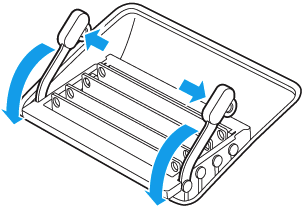
- After the memory cage is released, pull the memory cage levers toward you, allowing access to each DIMM slot.
- Remove a DIMM by pulling the module straight up and out. Note the location of the notch on the bottom of the DIMM. When reinstalling DIMMs, the notch must be oriented correctly or the DIMM won’t fully insert:
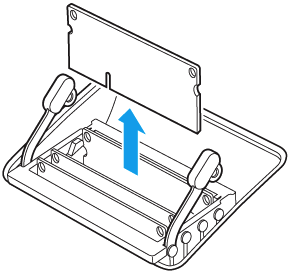
Replace or install a DIMM by setting it down into the slot and pressing firmly until you feel the DIMM click into the slot. The DIMM slot shown below is for iMac (27-inch, Late 2013) and iMac (Retina 5K, 27-inch, Late 2014, Mid 2015, and Late 2015). It requires that you insert the DIMM with the notch on the bottom, oriented towards the right:
iMac (27-inch, Late 2012) and iMac (Retina 5K, 27-inch, 2017) have the notch on the bottom left:
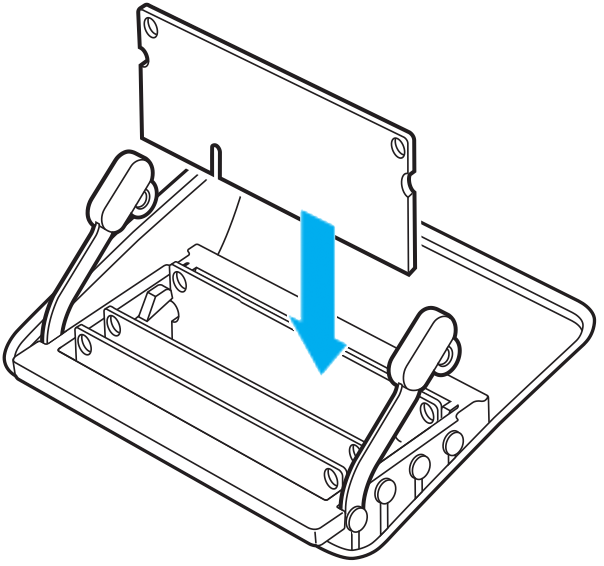
After you install all of your DIMMs, push the memory cage levers back into the housing until they click back into place:
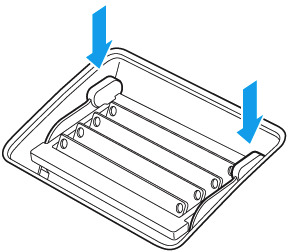
Replace the memory compartment door. You don’t need to press the compartment door release button when replacing the compartment door.
Place the computer in its upright position. Reconnect the power cord and all other cables to the computer, then start up the computer.
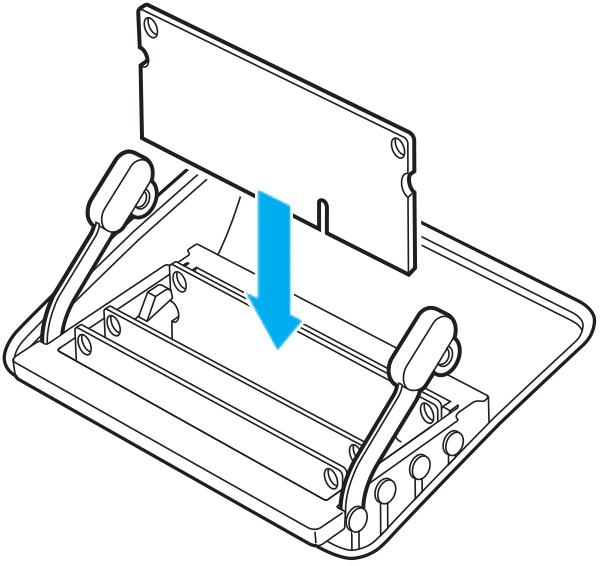
Your iMac performs a memory initialization procedure when you first turn it on after upgrading memory or rearranging DIMMs. This process can take 30 seconds or more, and the display of your iMac remains dark until it’s finished. Make sure to let the memory initialization complete.
Installing memory in the bottom slot
The internal components of your iMac can be warm. If you’ve been using your iMac, wait ten minutes after shutting it down to let the internal components cool.
After you shut down your iMac and give it time to cool, follow these steps:
- Disconnect the power cord and all other cables from your computer.
- Place a soft, clean towel or cloth on the desk or other flat surface to prevent scratching the display.
- Hold the sides of the computer and slowly lay the computer face-down on the towel or cloth.
- Using a Phillips screwdriver, remove the RAM access door on the bottom of the iMac and set it aside:
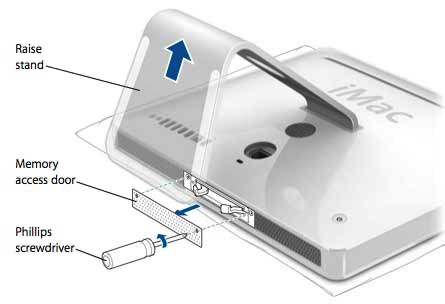
- Move the DIMM ejector clips to their fully open position:
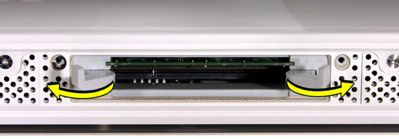
- Insert your RAM SO-DIMM into the bottom slot, keeping in mind the orientation of the keyed SO-DIMM:
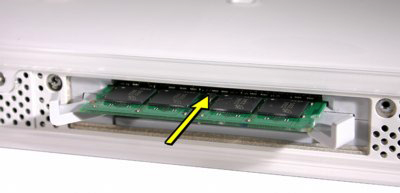
- After you insert it, press the DIMM up into the slot with your thumbs. Don’t use the DIMM ejector clips to push in the DIMM, as this might damage the SDRAM DIMM. There should be a slight click when you seat the memory fully.
- Close the ejector clips:
- Reinstall the memory access door:
- Place the computer in its upright position. Reconnect the power cord and all other cables to the computer, then start up the computer.
Replacing memory in the top slot
After you shut down your iMac and give it time to cool, follow these steps:
- Disconnect the power cord and all other cables from your computer.
- Place a soft, clean towel or cloth on the desk or other flat surface to prevent scratching the display.
- Hold the sides of the computer and slowly lay the computer face-down on the towel or cloth.
- Using a Phillips screwdriver, remove the RAM access door on the bottom of the iMac and set it aside:

- Pull the two levers on each side of the memory compartment to eject the memory module that’s already installed:

- Remove the memory module from your iMac as shown below:
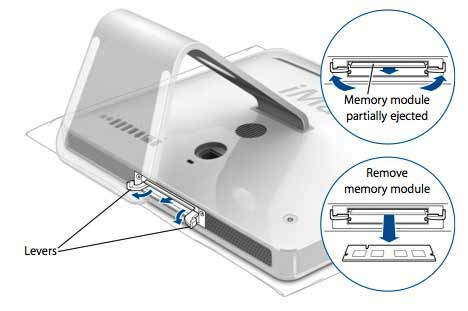
- Insert your RAM SO-DIMM into the top slot, noting the orientation of the keyed SO-DIMM:

- After you insert it, press the DIMM up into the slot with your thumbs. Don’t use the DIMM ejector clips to push in the DIMM, as this might damage the SDRAM DIMM. There should be a slight click when you seat the memory fully.
- Close the ejector clips:
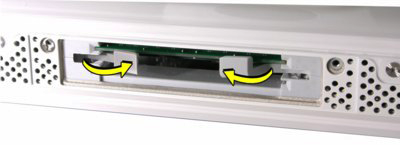
- Reinstall the memory access door:
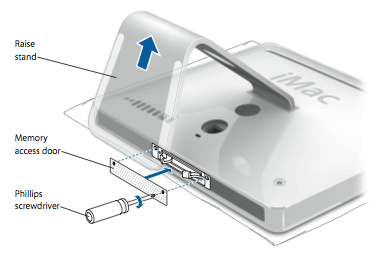
- Place the computer in its upright position. Reconnect the power cord and all other cables to the computer, then start up the computer.

If your iMac makes a tone after you install memory
iMac models introduced before 2017 might make a warning sound when you start up after installing or replacing memory:
- One tone, repeating every five seconds signals that no RAM is installed.
- Three successive tones, then a five-second pause (repeating) signals that RAM doesn’t pass a data integrity check.
If you hear these tones, confirm that the memory you installed is compatible with your iMac and that it’s installed correctly by reseating the memory. If your Mac continues to make the tone, contact Apple Support.

Confirm that your iMac recognizes its new memory
After you install memory, you should confirm that your iMac recognizes the new RAM by choosing Apple () menu > About This Mac.
The window that appears lists the total memory, including the amount of memory that originally came with the computer plus the newly added memory. If all the memory in the iMac has been replaced, it lists the new total of all installed RAM.
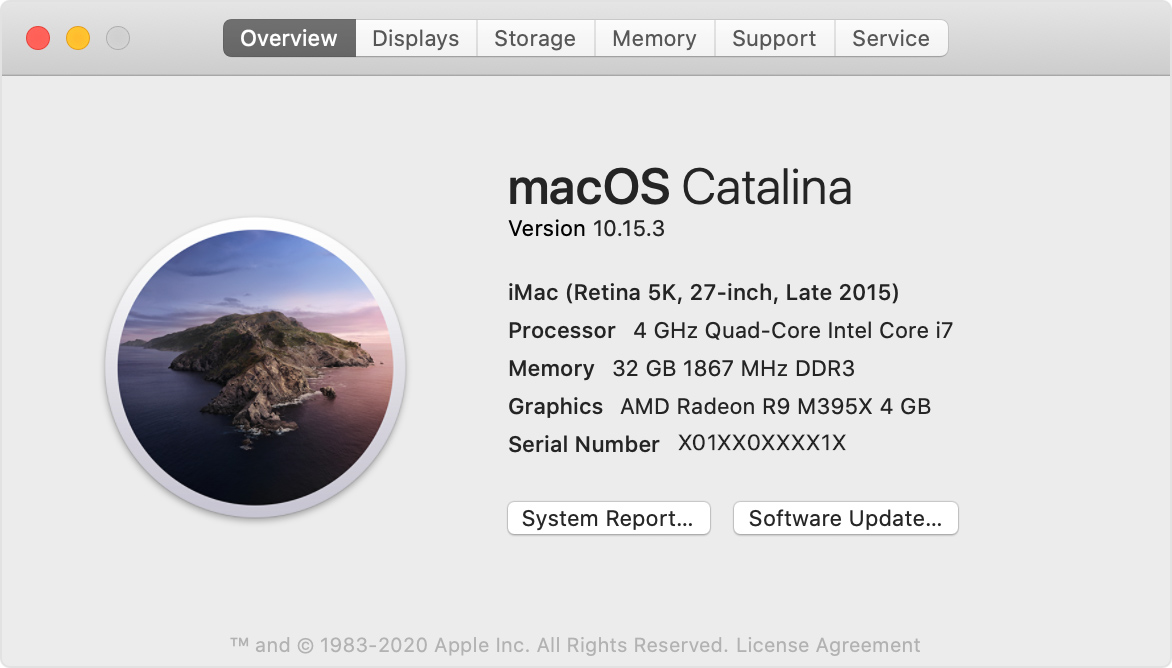
For detailed information about the memory installed in your iMac, click System Report. Then choose Memory under the Hardware section in the left side of System Information.
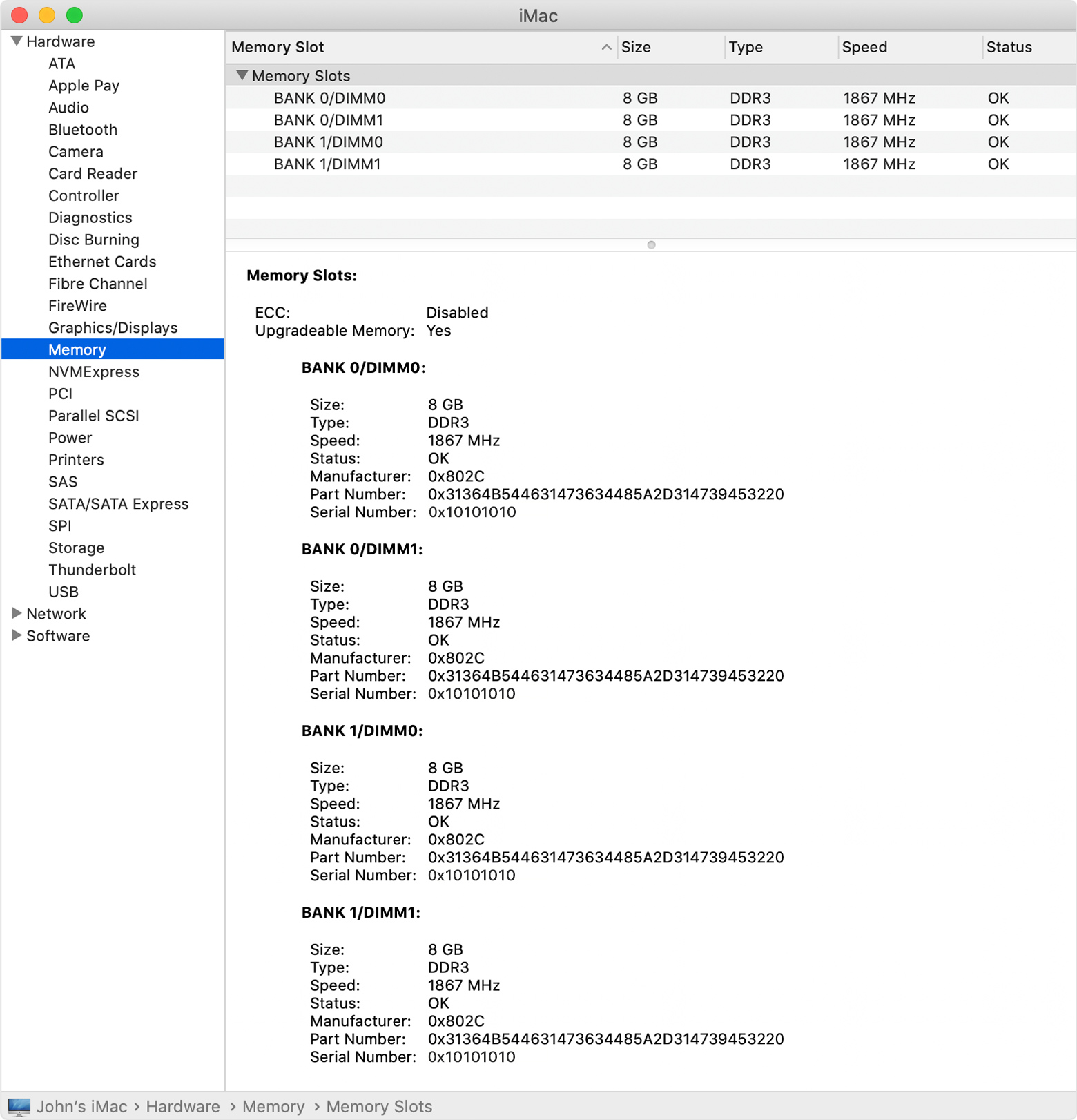
If your computer doesn’t recognize the memory or doesn’t start up correctly, confirm that the RAM you installed is compatible with your iMac and that it’s installed correctly by reseating the memory. If you continue to have issues with the memory in your iMac, contact Apple Support.
